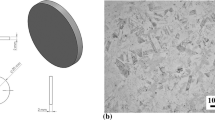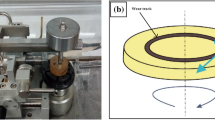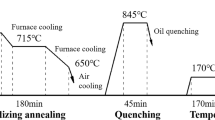Abstract
This study investigates the energy dissipation and application of a simplified incremental wear model to assess its effectiveness in predicting the wear behavior of three specific bearing materials (phosphorus bronze, gunmetal, and aluminum 6061) under dry sliding/rolling conditions. The wear experiments were conducted using twin disk rolling/sliding tribometers at different applied loads of 49, 98, and 147 N, while maintaining a fixed slip ratio of 4%. The wear depth changes were periodically measured over a total sliding distance of 1860 m experimentally as well through simplified wear model in MATLAB®. The wear depths obtained from the experimental data were compared with the wear depths predicted by the incremental wear model for the three selected material pairs: (i) phosphor bronze, (ii) gunmetal, and (iii) aluminum alloy with EN31 as the counterface disk material. The simulated wear depth results showed good qualitative and quantitative agreement with the experimental results, with errors of 6.4, 6.8, and 10.7% for the aluminum disk, gunmetal disk, and phosphor bronze disk, respectively. Overall, the wear model was found to be computationally efficient in estimating the dry wear behavior and service life of chosen bearing tribo pairs.








Similar content being viewed by others
Data Availability
All required data are included in the manuscript.
Abbreviations
- A :
-
Contact area [mm2]
- E:
-
Young’s modulus [Pa]
- F N :
-
Applied normal load [N]
- H :
-
Hardness [N/mm2]
- K :
-
Dimensionless wear coefficient [–]
- K D :
-
Specific wear rate [mm3/Nm]
- L :
-
Sliding distance [m]
- N :
-
Number of rotations [–]
- R 1 :
-
Radius of upper disk [m]
- R 2 :
-
Radius of lower disk [m]
- R eq :
-
Equivalent radius of curvature [m]
- V :
-
Worn volume [mm3]
- h w :
-
Wear depth [µm]
- i :
-
Increment [–]
- p :
-
Pressure [Pa]
- p o :
-
Average contact pressure [Pa]
- s :
-
Sliding distance [m]
- dt :
-
Small time change [s]
- u :
-
Elastic displacement [m]
- u :
-
Rolling velocity [m/s]
- u :
-
Sliding velocity [m/s]
- v :
-
Linear velocity [mm/s]
- δt i :
-
Increment of time [s]
- θ :
-
Circumferential coordinate [–]
- ν :
-
Poisson’s ratio [–]
- σ :
-
Stress [Pa]
References
V. Hegadekatte, J. Hilgert, O. Kraft, N. Huber, Multi time scale simulations for wear prediction in micro-gears. Wear. 268(1–2), 316–324 (2010)
U. Olofsson, S. Andersson, S. Björklund, Simulation of mild wear in boundary lubricated spherical roller thrust bearings. Wear. 241(2), 180–185 (2000)
G.E. Morales-Espejel, V. Brizmer, Micropitting modelling in rolling–sliding contacts: application to rolling bearings. Tribol. Trans. 54(4), 625–643 (2011)
B. Li, P. Li, R. Zhou, X.Q. Feng, K. Zhou, Contact mechanics in tribological and contact damage–related problems: a review. Tribol. Int. 171, 107534 (2022)
H.C. Meng, K.C. Ludema, Wear models and predictive equations: their form and content. Wear. 181, 443–457 (1995)
K. Feng, J.C. Ji, Q. Ni, M. Beer, A review of vibration-based gear wear monitoring and prediction techniques. Mech. Syst. Signal Process. 182, 109605 (2023). https://doi.org/10.1016/j.ymssp.2022.109605
J.A.A. Williams, Wear modelling: analytical, computational and mapping: a continuum mechanics approach. Wear. 225, 1–17 (1999)
A.I. Vakis, V.A. Yastrebov, J. Scheibert, L. Nicola, D. Dini, C. Minfray, A. Almqvist, M. Paggi, S. Lee, G. Limbert, J.F. Molinari, M. Ciavarella, Modeling and simulation in tribology across scales: an overview. Tribol. Int. 125, 169–199 (2018)
A. Winkler, M. Bartz, S. Wartzack, Numerical wear modeling in the mixed and boundary lubrication regime. Lubricants. 10(12), 334 (2022)
B. Kanavalli, Application of user defined subroutine UMESHMOTION in ABAQUS for simulating dry rolling/sliding wear. Skolan för industriell teknik och management, Kungliga Tekniska högskolan (2006), p. 34
P.L. Ko, S.S. Iyer, H. Vaughan, M. Gadala, Finite element modelling of crack growth and wear particle formation in sliding contact. Wear. 251, 1265–1278 (2001)
F.J. Franklin, I. Widiyarta, A. Kapoor, Computer simulation of wear and rolling contact fatigue. Wear. 251, 949–955 (2001)
F.J. Franklin, G.-J. Weeda, A. Kapoor, E.J.M. Hiensch, Rolling contact fatigue and wear behaviour of the infracted two-material rail. Wear. 258, 1048–1054 (2005)
N. Stalin-Muller, K.V. Dang, Numerical simulation of the sliding wear test in relation to material properties. Wear. 203–204, 180–186 (1997)
C. Christofides, P.E. McHugh, A. Forn, J.A. Picas, Wear a thin surface coating: modeling and experimental investigations. Comput. Mater. Sci. 25, 61–72 (2002)
J.F. Molinari, M. Ortiz, R. Radovitzky, E.A. Repetto, Finite element modeling of dry sliding wear in metals. Eng. Comput. 18, 592–609 (2001)
V. Hegadekatte, N. Huber, O. Kraft, Finite element-based simulation of dry sliding wear. Model. Simul. Mater. Sci. Eng. 13, 57–75 (2005)
V. Hegadekatte, N. Huber, O. Kraft, Finite element-based simulation of dry sliding wear. Tribol. Lett. 24, 51–60 (2006)
B. Bhushan, Contact mechanics of rough surfaces in tribology: multiple asperity contact. Tribol. Lett. 4, 1–35 (1998)
Q. Lian, G. Deng, A.K. Tieu, H. Li, Z. Liu, X. Wang, H. Zhu, Thermo-mechanical coupled finite element analysis of rolling contact fatigue and wear properties of a rail steel under different slip ratios. Tribol. Int. 141, 105943 (2020)
L. Zhou, H. Ding, Z. Han, C. Chen, Q. Liu, J. Guo, W. Wang, Study of rolling-sliding contact damage and tribo-chemical behaviour of wheel-rail materials at low temperatures. Eng. Fail. Anal. 134, 106077 (2022)
B. Zhang, H. Liu, C. Zhu, Y. Ge, Simulation of the fatigue-wear coupling mechanism of an aviation gear. Friction. 9, 1616–1634 (2021)
J.F. Santa, P. Cuervo, P. Christoforou, M. Harmon, A. Beagles, A. Toro, R. Lewis, Twin disc assessment of wear regime transitions and rolling contact fatigue in R400HT–E8 pairs. Wear. 432, 102916 (2019)
I. El-Thalji, E. Jantunen, A descriptive model of wear evolution in rolling bearings. Eng. Fail. Anal. 45, 204–224 (2014)
J. Archard, Contact and rubbing of flat surfaces. J. Appl. Phys. 24(8), 981–988 (1953)
V. Hegadekatte, S. Kurzenhäuser, N. Huber, O. Kraft, A predictive modeling scheme for wear in tribometers. Tribol. Int. 41(11), 1020–1031 (2008)
M. Amiri, M.M. Khonsari, On the thermodynamics of friction and wear-a review. Entropy. 12(5), 1021–1049 (2010)
H. Mohrbacher, J.-P. Celis, J.R. Roos, Laboratory testing of displacement and load induced fretting. Tribol. Int. 28(5), 269 (1995)
M.Z. Huq, J.-P. Celis, Reproducibility of friction and wear results in ball-on-disc unidirectional sliding tests of TiN–alumina pairings. Wear. 212, 151 (1997)
S. Fouvry, H. Zahouani, P. Kapsa, L. Vincent, Quantification of fretting damage. Wear. 200, 186 (2006)
M.Z. Huq, J.-P. Celis, Expressing wear rate in sliding contacts based on dissipated energy. Wear. 225–229, 53 (1999)
J.P. Celis, E. Vancoille, H. Mohrbacher, L. Stals, in Surface Modification Technologies XI, ed. T.S. Sundarshan, M. Jeandin, K.A. Khor (IOM Communications, 1998), p. 860
M. Jahangiri, M. Hashempour, H. Razavizadeh, H.R. Rezaie, A new method to investigate the sliding wear behaviour of materials based on energy dissipation: W–25 wt% Cu composite. Wear. 274, 175–182 (2011)
M. Jahangiri, M. Hashempour, H. Razavizadeh, H.R. Rezaie, Application and conceptual explanation of an energy-based approach for the modelling and prediction of sliding wear. Wear. 274, 168–174 (2012)
W.Y. Yang, W. Cao, J. Kim, K.W. Park, H.H. Park, J. Joung, T. Im, Applied Numerical Methods Using MATLAB. (John Wiley & Sons, 2020)
D. Kumar, Recent advances in tribology of high entropy alloys: a critical review. Prog. Mater. Sci. 136, 101106 (2023)
V. Saini et al., Augmenting the lubrication performance of nano-oils through synergistic co-functioning of nanoparticles. Tribol. Int. 182, 108332 (2023)
Y. Zhou, C. Zhu, H. Liu, A micropitting study considering rough sliding and mild wear. Coatings. 9(10), 639 (2019)
L. Xu, X. Fan, S. Wei, D. Liu, H. Zhou, G. Zhang, Y. Zhou, Microstructure and wear properties of high-speed steel with high molybdenum content under rolling-sliding wear. Tribol. Int. 116, 39–46 (2017)
Acknowledgments
We would like to show our gratitude to Advance Tribology Research Centre of CSIR-Indian Institute of Petroleum (Dehradun) for providing us the concept, facilities, and consumables for the research. We would also like to thank the National Institute of Technology, Srinagar, for providing monetary support for the entire duration of the project.
Author information
Authors and Affiliations
Contributions
VS contributed to conceptualization, methodology, testing, analysis, and writing original manuscript. UM contributed to formal analysis, testing worn disk, and analysis. GDT contributed to conceptualization, editing, supervision, and project administration.
Corresponding author
Ethics declarations
Conflict of interest
The authors declare no conflict of interest.
Additional information
Publisher's Note
Springer Nature remains neutral with regard to jurisdictional claims in published maps and institutional affiliations.
Supplementary Information
Below is the link to the electronic supplementary material.
Rights and permissions
Springer Nature or its licensor (e.g. a society or other partner) holds exclusive rights to this article under a publishing agreement with the author(s) or other rightsholder(s); author self-archiving of the accepted manuscript version of this article is solely governed by the terms of such publishing agreement and applicable law.
About this article
Cite this article
Saini, V., Maurya, U. & Thakre, G.D. Estimating the Dry-Wear Behavior of Rolling/Sliding Bearings (PB, Gunmetal, and Al6061)–Tribo Materials. J Fail. Anal. and Preven. 23, 2439–2451 (2023). https://doi.org/10.1007/s11668-023-01770-0
Received:
Accepted:
Published:
Issue Date:
DOI: https://doi.org/10.1007/s11668-023-01770-0




